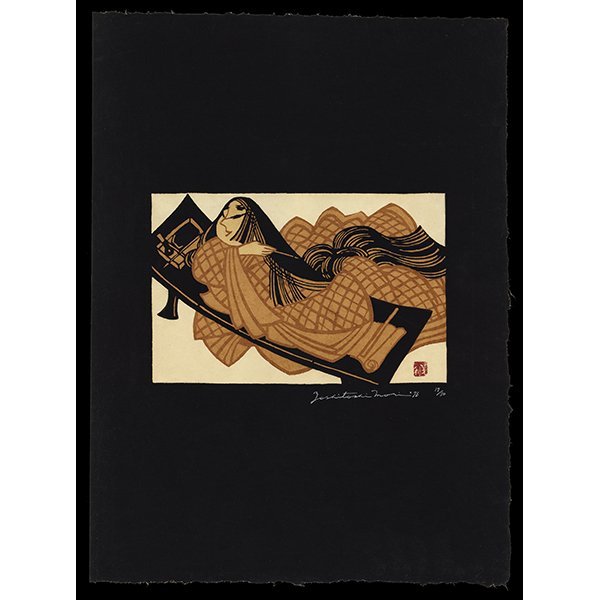<b>OCHANOMIZU AT NIGHT</b> / Yoshitoshi Mori1952<b>SOLD</b></em>
ARTIST: Yoshitoshi Mori (1898-1992)
TITLE: Ochanomizu at Night
MEDIUM: Stencil
DATE: c. 1952
DIMENSIONS: 21 1/4 x 15 3/8 inches
CONDITION: Excellent; faint foxing in image
LITERATURE: Tokyo Prefecture Chuoku Board of Education, Collection of Yoshitoshi Mori's Works, 1993, pg.33
SOLD
ARTIST: Yoshitoshi Mori (1898-1992)
TITLE: Ochanomizu at Night
MEDIUM: Stencil
DATE: c. 1952
DIMENSIONS: 21 1/4 x 15 3/8 inches
CONDITION: Excellent; faint foxing in image
LITERATURE: Tokyo Prefecture Chuoku Board of Education, Collection of Yoshitoshi Mori's Works, 1993, pg.33
SOLD
ARTIST: Yoshitoshi Mori (1898-1992)
TITLE: Ochanomizu at Night
MEDIUM: Stencil
DATE: c. 1952
DIMENSIONS: 21 1/4 x 15 3/8 inches
CONDITION: Excellent; faint foxing in image
LITERATURE: Tokyo Prefecture Chuoku Board of Education, Collection of Yoshitoshi Mori's Works, 1993, pg.33
SOLD
Details
For over three decades, Mori Yoshitoshi worked as a celebrated kimono designer using a stencil-based technique to dye his textiles. Though his textile work was demanding, Mori nonetheless found time to learn to draw and paint. After WWII, Mori toured the streets of bombed-out Tokyo, sketching and painting the devastation and reconstruction efforts. Mori was fascinated by the rapid changes to post-war Tokyo, and it was during this time the fledgling artist developed and honed his artistic eye. Mori’s textile dying technique catalyzed the production of his stencil prints, as he adapted the method to produce his hanga. In the late 1950s, Mori abandoned his textile work and dedicated his artistic efforts exclusively to prints.
In this striking night scene, Mori provides us with a contorted cityscape where the composition twists and turns onto itself almost in an M.C. Escher–like fashion. The river, which travels through the design, is partially lit by the inconsistent and jarring light of the city. Shadows emerge as somewhat recognizable forms, only to dissolve inches away in mystery. The lights emanating from the windows in the office buildings at left and at the upper portions of the design help to stake out the dimensions and orientation of the composition. However, the viewer is left disoriented by the meandering shadows through this dreamlike cityscape. It is interesting to note that this design is one of Mori’s earliest works executed when he moved back to Tokyo to begin his hanga career in earnest. It must have been an exciting and confusing time for the artist, and all the large-scale changes to the city in post-war Tokyo must have only added to the confusion.
Connoisseur's Note
Like all of his early works, Mori produced this stencil print on thick, smooth, textile-like paper. Mori’s choice in paper is not surprising as he was relying heavily on his experience with textiles in the production of early prints. Mori would later utilize a thinner but stronger paper that he crumbled by hand, giving it a textile-like feel before the design was imprinted.
The painting Mori produced as the study for this print design survives and is illustrated below. This original work provides the viewer with a clear understanding of the orientation of the print, as all elements in the design are in focus and clearly delineated. However, the power and emotional potency of the print is sorely lacking in this original work.





